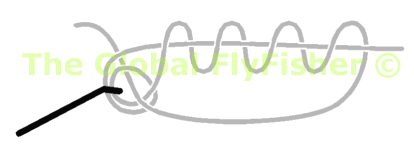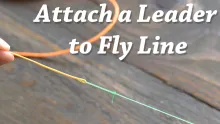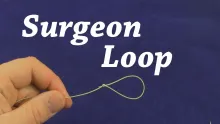This article is a simple illustrated list of the most useful knots for the fly angler - or any fisherman for that matter.
Read the intro to the knot section
About setting up reel, backing and line
About tying your own leaders
Leader and tippet Q&A
A test in the print magazine Fly Fisherman showed the Trilene and the Orvis knot to be equally strong and on top of that said that they were able to maintain 100% of the line strength. I really have my doubt if that will hold for all types and thicknesses of line, but still it does prove that these could be the knots of choice for the concerned fly fisher.
I personally prefer knots that pass the line through the eye twice - like the Trilene and the Palomar knot. My favorite loop knot is the Surgeons loop which is easy to tie and has served me well. If I need a guiding knot, I tie the Moerrum Guiding knot.
| Fly attachment knots |
Palomar knotA knot that is easy to tie and has a good breaking strength of over 90%. It can be difficult passing the line twice through the hook eye, but pass the tag end though one way first and then back. Then make the loop as small as possible and pass it over the hook. Tighten by first pulling both ends - then the tag end alone. |
Surgeons loopA loop which can be used to tie on small flies or flies that need to work on the leader. The knot is strong, but the open loop is a bit fragile where the fly wears it, so the knot ought to be inspected and retied regularly. Make sure you do not tie the loop too large as it and the knot has a tendency to grab any material on the fly and lock. This will often lead to a fly swimming backwards... |
Duncan loopThe classical loop for flies that need to work freely on the tippet. Fairly easy to tie and can be tightned according to taste. |
Orvis knotCan form a loop that tightens when under strain. Its strength almost compares to the Trilene knot with a 95% avarage. |
Figure 8 loop
|
Trilene knotThe breaking strength is very high for this knot; very close to 100% for some lines and diameters and almost always above 90%. Do not cut the tag end too close. The knot has a tendency to untie itself after many casts. |
Moerrum Guiding knotA guiding knot well suited for up or down eye flies on heavy tippets especially salmon flies. The knot is easy to tie with a good breaking strength. Tighten the loop section first and then work it slowly to a position in under and almost in the hook eye. |
Improved clinch knot (not recommended)This is a very common knot, but even though it seems to look much like the Trilene knot, it's very weak in comparison. Down to 60% breaking strength in some cases. I do not recommend using it. |
| Leader knots - mono to mono |
Blood knotA knot used to tie two monofilaments together, i.e. tippet to leader or two pieces of a knotted leader. The knot is a bit difficult to tie, but can be tied without tools with some practise. It is compact and has a high breaking strength and leaves the line absolutely straight. The number of turns can be varied, but 3-5 turns work well on most lines. Cut the tag ends very close to the knot with a clipper to keep them from grabbing all kinds of weed and debris in the water (not like in the picture, but as close as you can get).. |
Surgeon's knotThis knot is normally used to tie two monofilaments together, i.e. tippet to leader. The knot is fast and easy to tie and has a high breaking strength. It does require one side to pass through the loop and is more bulky than the Blood knot. It also leaves a small angle on the line. The number of turns can be varied, but two turns work best on most lines. |
| Leader knots - mono to fly line |
Needle knotAn excellent knot for attaching the leader to the fly line. It yeilds a very neat, straight and strong transition between the monofilament leader and coated fly line. |
Nailless nail knotAn fine knot for field attachment of a leader to the fly line. It is almost as straight and strong as the above nail knot, but can fail if the coating is pulled off the fly line core. |
For some reason these illustrations and the text has become some of the most copied items on GFF ever... we can't really see why, but that seems to be the case. They have been used extensively all over the web without our permission. Because of this we have now overlayed all illustrations with the ugly green copyright text, making it just a bit more difficult to use the images without leaving traces of their origin. Leave no room for doubt: All this content is copyrighted! It can't be used anywhere else without our written permission.
- Log in to post comments






























Might want to check
Might want to check your illustration for the blood knot... the wraps should be opposing. If you are looking "down the line" on one side of the knot, the wrap of the end of the other line should be counter-clockwise, then look at the knot from "down the line" on the other side and the wraps should again be counter-clockwise so that the wraps oppose each other... it is hard to explain.
Wax that sewing need
Wax that sewing needle or dip it in a thread conditioner such as "Thread Heaven". It will slip more easily. Also, in regard to the technique involving pushing the needle through backward, when you make your cut in the side of the flyline, a 20ga hypodermic needle has a very sharp, controllable bevel on it's end that serves well as a tiny knife. The word sharp bears mentioning twice. It will make it very easy to keep your cut the length you want it. It's also the ideal size for cutting down to a splinter in your skin, allowing you to lift it out easily.
This is an excellent
This is an excellent photo. What camera did you use for this, because it has really high clarity and depth levels.
Your Trilene knot ne
Your Trilene knot needs adjusting. When pulled up correctly the loops in the eye of the hook do not cross, but lay side by side. Crossing the loops causes stress at the crossing point and failure at the knot. The trick to drawing the knot up correctly is tightening the knot using the hook shank and lead end to draw it up with minimal pressure on the tag end.
Other than this detail, an excellent article.
I stripped back the
I stripped back the coating on the fly line just leaving the nylon braid and tied an albright knot to the leader..The knot diameter is the same as the nail knot....Anyone know any reasons why this wouldnt be suitable. I'm new to fly fishing.
AMAZING! All my life
AMAZING! All my life since I was about 8, I have been using half blood knots and clinch knots for fly fishing, spinning and bait fishing. (I am now 17) And just decided to do some basic test without a gauge on some knots.
The unimproved and improved Clinch knots are horrible compared to the Trilene, Palamar and Orvis knots.
I can so simply break 6lb line (just what was lying around) on the half blood knots and the clinch knots whereas with the aforementioned other 3 it's much much harder... regardless of how similar the Trilene knot looks to the clinch knot and half blood knot, it's at least 1.7 times stronger.. which is a huge difference.
From now on I will be using the Trilene knot in place of everything I used a half blood knot and clinch knot for.
When forming the loo
When forming the loop for the surgeons knot, give the loop a half twist before passing the ends through. The tag end or dropper will stand out at exactly 90 degrees to the leader. Stops those pesky weighted nymphs and other flies wrapping around the leader.
Anonymous,
Also c
Anonymous,
Also check out our Q&A where I added your question and an answer.
Martin
For Anonymous- When
For Anonymous- When the fly line has a loop in the running line for attachment I make a loop in my backing using any of the following knots- Bimini, spider hitch or 5 turn surgeon's knot. Now all you have to do is attach the flyline loop to loop to your backing.
how do i tie backing
how do i tie backing on to new fly line with a loop on it
Quite good, got me o
Quite good, got me on the right track!
found this artical v
found this artical very helpfull as ive just picked up a fly rod. many sites that give info but not as indepth or explaining things so i a novice can easily understand very helpfull.
Info was quite helpf
Info was quite helpful.
Phil D's method for
Phil D's method for the needle knot is a revelation! Went nuts trying to do one on a 3wt. Off to the shop to get it right! Thanks...
About the Needle Kno
About the Needle Knot -- Suggest you try the following method to solve problems of small fly line diameter and needle eyes too small for leader butts. Easier than it sounds, and makes a nice finished knot. Cut fly line off square. Use point of unthreaded needle to start hole up fly line core. Then reverse the needle and work the eye end up into the fly line core about 10 mm. Against the rigidity of the needle inside the line, use a razor blade to make a careful small cut in the outside of the fly line at about 8 mm. Grip point of needle and carefully pull the needle back out of the end of the fly line just past your cut in the side of the line, and then push just the eye of the needle out through the cut. Thread the small end of the leader through the needle, then grip point of needle and pull it out of end of fly line. Pull the entire leader out end of fly line, except for leaving several inches of the leader butt sticking out the side of the fly line. Tie the knot as shown in picture. Many leader butts are too stiff to wrap well in the knot. Cut the butt off at a diameter that will wrap the knot, but not so small that the leader makes a flimsy hinge where it emerges from tip of fly line. Coat uneven spots with flex glue. And there it is !
I tied 20 clinch kno
I tied 20 clinch knots last night and 20 trilenes, then pulled them to failure. The clinch knots all failed at the knot and noticebly with less pressure needed. Only 2 trilenes failed at the knot 18 were snapped mainlines. I used 4lb Xcelon.
nail knots are a bre
nail knots are a breeze if you pull the thin end of the leader through first, starting a short distance up the line from the end. Pull through till there is enough of the butt end of the lelader left to make the knot and proceed.
John, I'm not sure i
John, I'm not sure if I completely understand what you're trying to do, but I have been using needle knots for a couple of years now and the way I do it is to trim the butt end of the leader to a fine taper with a razor blade, I then thread the tapered end of the leader into the eye of the needle, bend it over to form as little resistance as possible. Then insert the needle into the fly line and pull the needle and leader through the fly line using a small pliers.
With a little practice I can trim 1 - 2 inches of the leader to a fine taper which makes it all much easier to pull through, it also helped me when I dug through my wifes sewing kit and found a small needle with a eye large enough to easily fit the taper into.
hope this helps
Paul
John,
The needle
John,
The needle knot where the needle goes through the fly line is tricky exactly for the reason you mention - keeping the hole open while you poke the leader through. Two things help:
1) Use an oversize needle. As you have notice the hole closes anyway, so working the hole larger is usually no problem. I have also worked with a hot needle sometimes, but this requires some delicacy in order not to melt the coating completely. I have also tried pressing the needle through the coating cold and then heating the part outside the fly line. This is easier to control, and makes the hole stay open when the needle is removed after cooling.
2) Cut the leader at an angle with a knife, razor blade or sharp scissors. This forms a tip, which is a lot easier to pass through the newly formed hole. I can read that you have done this already.
If none of this works, consider a nail less nail knot tied on the outside of the line or an Albright knot (used for backing here, but it works for leaders too) where the fly line is doubled back as shown here.
Tying the thick butt of the leader on to the supple fly line is a menace no matter what, so have patience.
Hope some of this works for you.
Martin
I've just spent an h
I've just spent an hour trying to tie a needle knot, and finally gave up. Clearly, I'm missing something. Is this knot intended for any type of line? I'm trying to use it to attach a 3x tapered leader to a WF 7 line. The tip of the 7 weight line is not much larger than the needle to begin with, and after pulling the needle out the line collapses shut again, and the hole in the side of the line disappears. It seems impossible to shove the (sharpened) butt of the leader up into the line, let alone out through the exit hole. Any advice?
For the Orvis knot l
For the Orvis knot lovers...I have also used the Orvis knot when attaching leader to tippet, aligning the leader and tippet in the same manner illustrated above surgeon's knot then tying the Orvis knot.
After two years of F
After two years of Fly fishing on the Musgeon River in Michigan for Steelhead I just came to the conclusion last weekend that the reason the fish keep snapping off my tippet is two fold. One is that the "Improved Clinch" that I have been using for over 40 years does suck and that the new Flourocarbon leaders are far superior to the standard nylon tippet. I ran a dozen tests using a new fishing scale and came to the exact conclusion that the "Improved Clinch" may better that an "Unimproved" Clinch but it really does suck and will lose you fish. Thanks for posting this site to give some validation to my personal testing and options for better performing knots. P.S. I am going to try the Orvis out, but will be testing it myself after what I have gone through....Knot that I don't believe you.... Hahaha
Hi from South Africa
Hi from South Africa. I love dry fly fishing with very light tackle. Im interested in finding a knot to the fly where the tippet is a few inches from the fly outside the water. This makes the fish less wary to take the fly. Assistance will be appreciated
Well, its funny to m
Well, its funny to me that so many people seem to love the "nailless nail knot". There is a reason why this knot has been carried down from generations long ago...its a snell knot. And a snell knot is what was used by early fishermen before hooks had "eyes". The nailless knot is just a slight variation of the snell for tying lines together. Its probably one of the oldest and best knots ever.
But why are we all debating knot terminology, we should be out there fishing!
That nailless nail k
That nailless nail knot is quite handy! A few weeks ago I took my brand new bamboo rod out to fish for the first time. Stopped and bought a line on the way to meet my friends. Got there, took delivery of reel in the parking lot where we were embarking on our creek trip. I realized that I needed a loop in the end of the line in order to attach my furled leader. The nailless nail knot secured a thoroughly adequate loop that performed well all day and has since been enhanced with some Loon UV Wader Repair.
I have come at fly f
I have come at fly fishing from a long history of spinning and baitcasting for large freshwater fish. I have always used a Palomar knot, and I carried this into fly fishing. Every once in a while, I carefully tie a clinch knot to see if I should switch to this much easier knot. But, each time it breaks in my hands much easier (I don't even need a scale!). You are only using 60% of your tippet with a clinch knot. Switch from 4x to 6x, use a Palomar, (or other high strength knot) and get more bites!
HI Martin,
HI Martin,
I use the needle knot on all my fly lines now for a couple of years, its far far the best way to present your lines thanks Jan
Justin,
The knot
Justin,
The knot grips the fly line coating very firmly, and will "bite" into it. The only times these knots seem to fail is when the coating comes off the fly line too easily. I have never had one of these nailless nail knots fail on me (knock on wood!).
Martin
I don't understand h
I don't understand how the nail knot is so strong. It seems like the whole knot could "slip" off the fly line. I realize it's time tested, but it just don't seem intuitive.
HI,i also have used
HI,i also have used the improved clinch knot for half a century, very seldom letting me down like C W(smallie)BOTTOM. I like to wrap at least 6 times round main line pass back through loop next to the eye then back through the loop above.wet this and pull on main line only gently to tighten,then when in place only then pull on the tag end firmly.REPEAT main line pull then tag end pull and dont trim off too close.I also always use this knot when worming and spinning for salmon and never and never encountered many problems.GOOD LUCK from BILL.
Yep, neither of the
Yep, neither of the nail knots is really a nail knot.
www.killroys.com/knots/nail.htm
They look more like a noose tied in rope.
Partly for Adrian, b
Partly for Adrian, but also for general:
How about a loop to loop connection. That is what I have with all my lines and leaders (except those few where I won't be changing leaders). Various ways to put a fancy loop on the end of the fly line, but on a new line I just make an end loop, whip it (same idea as the nailless nail knot above) and coat it with some fly head cement. For leaders I tie a Perfection loop in the butt end of the leader (and work hard and slowly to get it tight :-). Maybe Martin would add an entry on the Perfection loop to the above.
Orvis knot is the ki
Orvis knot is the king. I'll never tie a clinch for fishing again. Look for the Ligature Knot for line-to-line connections, its just as good of an improvement over blood knots, and much easier to tie.
If I might be so bol
If I might be so bold as to correct you on your knots. Your first leader to fly-line knot is in fact a needle knot. So called because a needle is used to first penetrate the end of the flyline. Your second knot is in fact a nail knot as a nail is used to take the wraps of nylon. The nail is then gently removed, the tag end is pushed through and the knot tightened. The nail can be used for both knots.
Duncan Loop is good,
Duncan Loop is good, easy and effective, but once it clinches after a strike it has to be redone or you loose about 50% strenght.
Wish there was one f
Wish there was one for sinking lines and how to attach mono to sinking flylines when wetlineing rivers has anyone got any pic's, diagrams onhow it is done?
The Morum Guiding Kn
The Morum Guiding Knot is the SAME as the Duncan Loop! - great Knot(s) though. Orvis knot does look interesting - hope its good on 6 and 7X tippet. (Will know tomorrow!)
The Orvis knot rocks
The Orvis knot rocks! I used to use the clinch knot to tie flies on my tippet, but never again! The Orvis knot is easy to tie and fast - I switch flies more often now if there's no action.
I tested out some of
I tested out some of these knots, and the Palomar and Orvis knots did seem to be better than the cinch. However, I had extreme difficulties in tying these two knots when using very small tippet.
I use the improved c
I use the improved clinch knot! Have been for over 40 years. It has served me well. I will use tomorrow on my splendid local stream. Those who dislike this knot may not be tying it correctly. A possibility!
Where can I learn ho
Where can I learn how to join the leader to the fly line using the inch worm knot?
Best tippet to dry fly knot!
The Double Davy knot is the best dry fly knot NO contest. Very simple, very fast, very strong, very reliable, very small footprint, little wasted tippet.